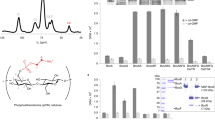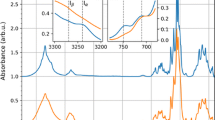Abstract
Two kinds of band-like cellulose assemblies, coarse and densestructures, are produced in Hestrin–Schramm medium at 4 °Cusing smooth colonies isolated from Acetobacter xylinumATCC23769, whereas ribbon cellulose assemblies are produced by the samecoloniesat 28 °C. The dense and the coarse band-like assembliesconsist of many strand-like cellulose entities (‘strands’) and areextruded perpendicularly to the long axis of the bacterial cell. In an earlystage of incubation at 4 °C, the dense band-like assembly isproduced and the number of strands decreases gradually with increasingincubation time at 4 °C, probably because the number of activeTC subunits decreases as a result of the low-temperature shock for thebacteria.In contrast, the coarse band-like assembly is clearly observed after about 1h of incubation at 4 °C. The number of strands inthe coarse band-like assembly is about one third of that of the dense band-likeassembly and does not change during the incubation time of about 6h. In the selected-area electron diffraction (ED) experiment, thedense band-like assembly gives crystalline reflections corresponding to thecellulose II type crystal, while the coarse band-like assembly does not giveanycrystalline reflections under the same ED conditions.
Similar content being viewed by others
References
Atalla R.H. and VanderHart D.L. 1984. Native cellulose: A composite of two distinct crystalline forms. Science 223: 283–285.
Brown R.M. Jr. 1996. The biosynthesis of cellulose. J. Macromol. Sci.-Pure Appl. Chem. A33: 1345–1373.
Brown R.M. Jr. 1998. Private communication; Biogenesis of natural polymer systems with special reference to cellulose assembly and deposition. In: Proceedings of the Third Philip Morris Science Symposium, 1978, pp. 52–123.
Brown R.M. Jr., Willison J.H.M. and Richardson C.L. 1976. Cellulose biosynthesis in Acetobacter xylinum: visualization of the site of synthesis and direct measurement of the in vivo process. Proc. Natl. Acad. Sci. USA 73: 4565–4569.
Delmer D.P. 1999. Cellulose biosynthesis; exciting times for a dif-ficult field of study. Annu. Rev. Plant Physiol. Plant Mol. Biol. 50: 245–276.
Hestrin S. and Schramm M. 1954. Synthesis of cellulose by Acetobacter xylinum. Biochem. J. 58: 345–352.
Haigler C.H. 1985. The functions and biogenesis of native cellulose. In: Nevell T.P. and Zeronian S.H. (eds), Cellulose Chemistry and Its Applications. Ellis Horwood Ltd, Chichester, UK, pp. 30–83.
Haigler C.H. and Benziman M. 1982. Biogenesis of cellulose I microfibrils occurs by cell-directed self-assembly in Acetobacter xylinum. In: Brown R.M. Jr. (ed.), Cellulose and Other Natural Polymer Systems. Plenum Press, New York, pp. 273–297.
Hirai A., Tsuji M. and Horii F. 1997. Culture conditions producing structure entities composed of Cellulose I and II in bacterial cellulose. Cellulose 4: 239–245.
Hirai A., Tsuji M. and Horii F. 1998a. Helical sense of ribbon assemblies and splayed microfibrils of bacterial cellulose. Sen'i Gakkaishi 54: 506–510.
Hirai A., Tsuji M., Yamamoto H. and Horii F. 1998b. In situ crystallization of bacterial cellulose III. Influences of different polymeric additives on the formation of microfibrils as revealed by transmission electron microscopy. Cellulose 5: 201–213.
Horii F. 2000. Structure of cellulose: Recent developments in its characterization. In: Hon D.N.-S. and Shiraishi N. (eds), Wood and Cellulosic Chemistry. Marcel Dekker, Inc., New York, pp. 83–107.
Horii F., Yamamoto H. and Hirai A. 1997. Microstructural analysis of microfibrils of bacterial cellulose. Macromol. Symp. 120: 197–205.
Kolpak F.J. and Blackwell J. 1976. Determination of the structure of cellulose II. Macromolecules 9: 273–278.
Kuga S., Takagi S. and Brown R.M. Jr. 1993. Native folded-chain cellulose II. Polymer 34: 3293–3297.
Langan P., Nishiyama Y. and Chanzy H. 1999. A revised structure and hydrogen-bonding system in cellulose II from a neutron fi-ber diffraction analysis. J. Am. Chem. Soc. 121: 9940–9946.
Ross P., Weinhouse H., Aloni Y., Michaeli D., Weinberger-Ohana P., Mayer R. et al. 1987. Regulation of cellulose synthesis in Acetobacter xylinum by cyclic diguanylic acid. Nature 325: 279–281.
Shibazaki H., Kuga S., Onabe F. and Brown R.M. Jr. 1995. Acid hydrolysis behaviour of microbial cellulose II. Polymer 36: 4971–4976.
Shibazaki H., Saito M., Kuga S. and Okano T. 1998. Native cellulose II production by Acetobacter xylinum under physical constraints. Cellulose 5: 165–173.
Stipanovic A.J. and Sarko A. 1976. Packing analysis of carbohydrates and polysaccharides. 6. Molecular and crystal structure of regenerated cellulose II. Macromolecules 9: 851–863.
Sugiyama J., Vuong R. and Chanzy H. 1991. Electron diffraction study on the two crystalline phases occurring in native cellulose from an algal cell wall. Macromolecules 24: 4168–4175.
Yamamoto H. and Horii F. 1993. CP/MAS 13C NMR analysis of the crystal transformation induced for Valonia cellulose by annealing at high temperatures. Macromolecules 26: 1313–1317.
Yamamoto H., Horii F. and Hirai A. 1996. In situ crystallization of bacterial cellulose II. Influences of different polymeric additives on the formation of celluloses I _ and I _ at the early stage of incubation. Cellulose 3: 229–242.
Zaar K. 1979. Visualization of pores (export sites) correlated with cellulose production in the envelope of the gram-negative bacterium Acetobacter xylinum. J. Cell Biol. 80: 773–777.
Author information
Authors and Affiliations
Rights and permissions
About this article
Cite this article
Hirai, A., Tsuji, M. & Horii, F. TEM study of band-like cellulose assemblies produced by Acetobacter xylinum at 4 °C. Cellulose 9, 105–113 (2002). https://doi.org/10.1023/A:1020195205030
Issue Date:
DOI: https://doi.org/10.1023/A:1020195205030




